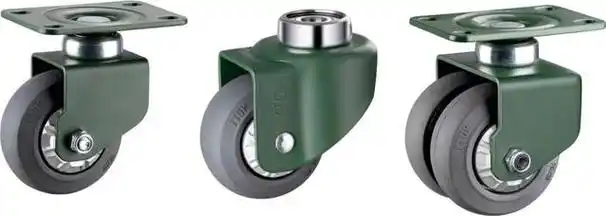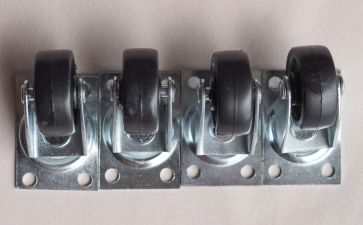- By YIKONG
- 2025-03-10 13:20:14
- TECHNICAL
How to choose the most suitable support casters for AGV?

With the diversification of application scenarios, choosing the right caster becomes the key. In the mobile robot industry, AGV (automatic guide vehicle) is a widely used device, and the choice of supporting casters is directly related to the stability, efficiency and service life of the device. With the gradual diversification of AGV application scenarios, its performance requirements for supporting casters are also constantly improving. How to choose casters that meet their needs has become the focus of many companies.
1. Load-bearing capacity and safety: the basic elements of selection
The first step in caster selection is to calculate the load-bearing capacity of a single caster, and the formula is:
T=(E+Z)/n×S
E: Equipment weight (weight of AGV itself)
Z: Maximum load (the weight of the cargo required by the equipment)
n: Number of casters
S: Safety factor
The safety factor S is considered to have deviations from the standard usage conditions (smooth ground, pace, uniform load distribution, straight line, ambient temperature from +15°C to +28°C).
When calculating the safety factor, the differences in the actual usage environment should be considered:
Indoor environment: safety factor is 1.2 to 1.5
Outdoor environment: safety factor is 1.5 to 2.2
The calculation of load-bearing capacity is not only the basis for ensuring the stable operation of the equipment, but also one of the most core steps in the selection process.
2. How to meet the needs of diverse scenarios
With the expansion of AGV application scenarios, support casters need to be versatile and adaptable. For example, casters need to adapt to different terrain and working environments to meet various load-load needs. At the same time, with the improvement of robot intelligence, casters also need to have adaptive performance and can automatically adjust performance according to different operating states to improve efficiency.
In addition, in scenarios where high-precision positioning is required, such as logistics sorting and intelligent warehousing, the high precision of casters is also particularly important. Support casters need to work seamlessly with the robot system to provide precise movement and operation capabilities.

3. Lightweight and low noise: taking into account both efficiency and environment
Lightweight design is the key to improving AGV efficiency. By reducing the weight of casters, it can not only reduce energy consumption, but also improve the handling flexibility of equipment. In some scenarios where operating noise is strictly required, such as medical institutions and libraries, low-noise casters can reduce operating interference and provide more possibilities for the expansion of equipment application.
4. Wear resistance and material selection: extend service life
Wear resistance is an important indicator to ensure the long-term and stable operation of AGV equipment. Choosing high-wear-resistant materials such as rigid polyurethane can not only extend the service life of casters, but also effectively reduce maintenance costs. In addition, the wheel core of the caster should be made of metal to enhance strength and load-bearing capacity.
Increase load-bearing priority: increase wheel diameter > adopt double row wheel > increase wheel width

Conclusion
When choosing AGV support casters, companies need to comprehensively consider factors such as load-bearing capacity, safety, wear resistance, lightweight, and low noise to ensure that the equipment can adapt to diverse application scenarios. Through reasonable selection, the operating efficiency of the equipment can not only be improved, but also extend its service life and create more value for the enterprise.



